By Charlie Dunne

If you were to tell me five years ago that my favorite watch to wear would be a vintage Rolex Submariner I would have laughed! “That is way too obvious of a watch!” would have likely been my response. Yet from late 2023 to now in 2024, I fell in love with the simple, no-date Submariner. Eric Wind and I have spent countless hours regaling others on the joys of owning and wearing vintage Rolex watches. There is no other product like them on the planet, and rather than owning something unique or rare, I find this somewhat obvious watch to be the most compelling on the wrist for daily use. Rolex’s quality control and continuous improvements have resulted in the simple fact that if taken care of properly, these watches will last a lifetime and beyond for many future generations. The faithful (and unrivaled) production of hermetically-sealed, chronometer-grade timepieces over the decades has resulted in one of the most recognized and appreciated products on the planet. There is one poignant quote from a 1965 Rolex advertisement that rings home:
“The value of the watch springs from a long history of outstanding achievements. And from its undoubted technical superiority. Before you agree to pay the premium which a limited-production watch demands, you should know about these things.”
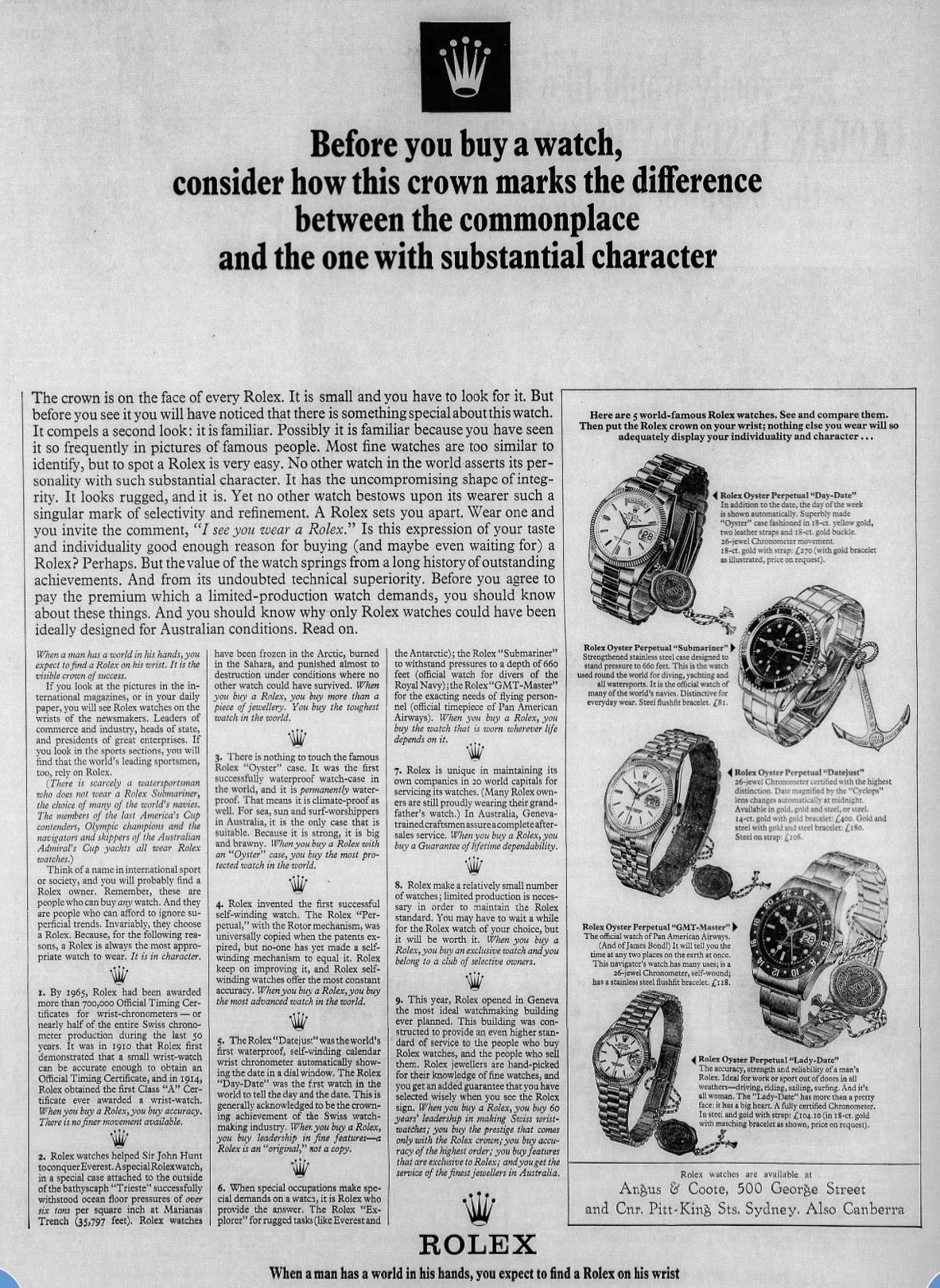
“The crown is on the face of every Rolex. It is small and you have to look for it. But before you see it you will have noticed that there is something special about this watch. It compels a second look: it is familiar. Possibly it is familiar because you have seen it so frequently in pictures of famous people. Most fine watches are too similar to identify, but to spot a Rolex is very easy. No other watch in the world asserts its personality with such substantial character. It has the uncompromising shape of integrity. It looks rugged, and it is. Yet no other watch bestows upon its wearer such a singular mark of selectivity and refinement. A Rolex sets you apart. Wear one and you invite the comment, “I see you wear a Rolex.” Is this expression of your taste and individuality good enough reason for buying and maybe even waiting for) a Rolex? Perhaps. But the value of the watch springs from a long history of outstanding achievements. And from its undoubted technical superiority. Before you agree to pay the premium which a limited-production watch demands, you should know about these things.”
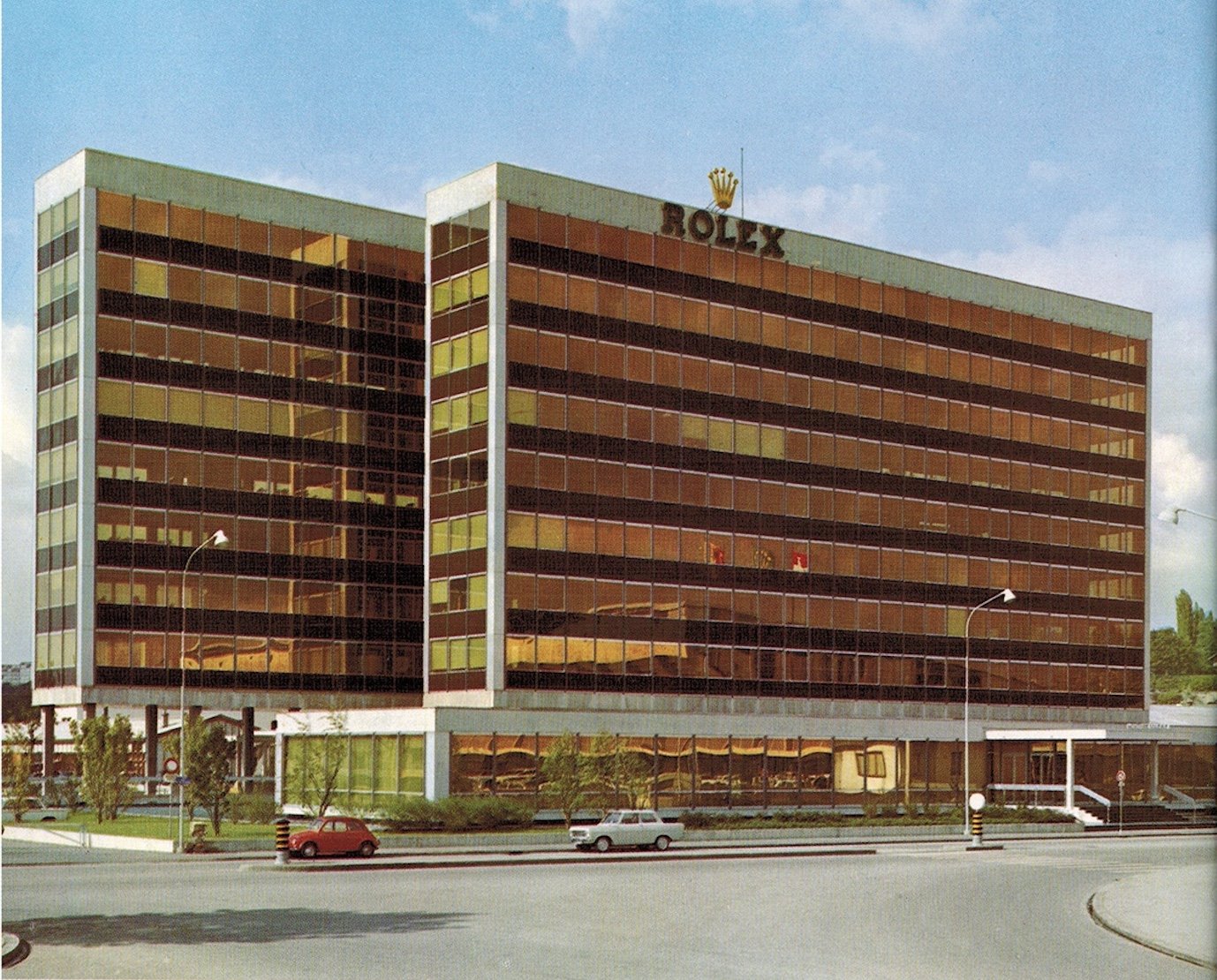
Rolex Headquarters Circa 1968
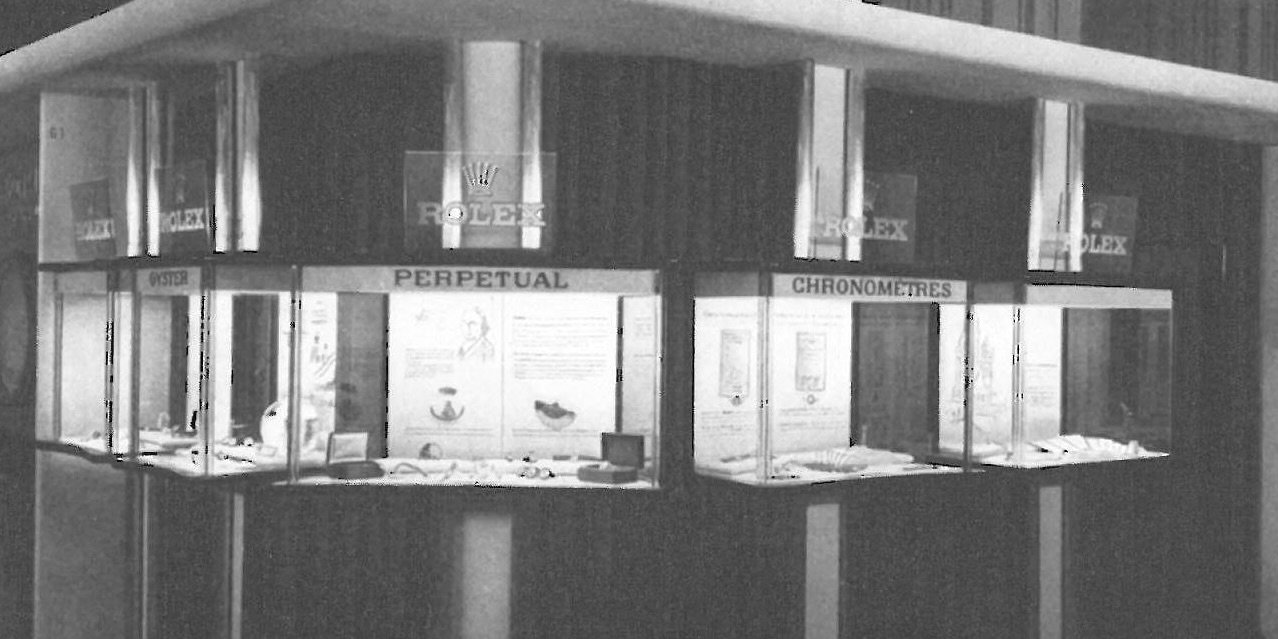
The Rolex booths segmented into Oyster, Perpetual and Chronometer sections at the 1946 Basel Fair. Source: Eric Wind’s 2015 Hodinkee article ‘Historical Perspectives A Look At Baselworld 1946”
When it comes to the category of dive watches, the Rolex Submariner is widely regarded as the most iconic watch. While Rolex Oyster models came before the Submariner – and the subsequent Sea-Dweller surpassed the standards/expectations of the model – it is the Submariner family which set the groundwork for most people when asked about the world’s prominent dive watch. The Submariner is undoubtedly the model that solidified the Oyster’s identity with consumers, and in turn was a major factor in the brand’s success. Certain watches like those from Panerai (Luminor and Radiomir), Jaeger-Lecoultre (Polaris), Enicar Sherpa (Ultradive), Vulcain (Cricket Nautical), and Blancpain (Fifty Fathoms, Aqua-Lung, and Tornek-Rayville) are highly admired. Yet, the Submariner has a mass appeal as the dive watch of choice. One important and differentiating factor as to why vintage-sports Rolex watches are so collectible – beyond the wide of the recognition of the brand – is that they are one of the few vintage watch models that can still be made water resistant.
When you look at the 1950s, it is clear that Rolex was heavily invested in the development and marketing of Submariner family with eight different references introduced (6204, 6205, 6200, 6536, 6538, 5510, 5508, and the 5512) from 1953-1959 – more models than years! Comparatively, the 5512/5513 case references would remain in continuous production over three decades. Sadly, Hans Wilsdorf’s passing in 1960 would prevent him from seeing the legacy of what would become two of the company’s most prolific models (the reference 5512 and reference 1675).
These watches are significant in that the reference 5512 would not only be the first Submariner reference to institute crown guards (or “shoulders” as Rolex initially called them), but it is the first Rolex watch to have crown guards. This case evolution helped protect the crown and stem against harmful impacts and proved to be quite influential for Rolex and other companies in the future. It could be surmised that Rolex influenced OMEGA to transition to crown guards and the asymmetrical case for the Speedmaster Professional starting with the reference 105.012 in 1963. The dimensions of the Submariner reference 5512 (and reference 5513) measure 40mm in diameter (42.5mm including crown) and 47mm lug-to-lug, It is approximately 14mm in thickness/height. These watches wear extremely well, whether you have a large or small wrist.
While the GMT-Master reference 1675 is a highly collectible sports watch with vibrant and beautiful bezel inserts, the Rolex Submariner reference 5512/5513 is a monochromatic watch with each bezel insert beginning its life in black. As an American hero and retired Navy Seal (and passionate watch collector) told me, “The GMT-Master is a flashy watch while the Submariner is optimal for those who need to be a bit stealthy. We wore Subs.” The less loud and universal look is perhaps part of the reason many collectors gravitate to the watch as a conservative choice for everyday use.
And for decades, the Submariner has been the watch purchased by young guys on Wall Street or in the world of hedge funds in Connecticut spending their first bonus check. Perhaps this has been part of the reason there has been less interest in Submariners in recent years – the same way people don’t choose to wear fleece vests by Patagonia unless they are “hedgies” as Eric’s Oxford MBA classmates would call them.
5512 vs. 5513

Left: A gilt dial reference 5513. Right: A matte dial reference 5512

(Note: Both the calibre 1560 and 1570 were used respectively in the Explorer reference 1016).
At first glance, the Submariner reference 5512 and reference 5513 appear identical. This is because these two references are siblings in the Rolex sports catalog. The reference 5512 was introduced in 1959 and was the debut Submariner with crown guards. It would remain in production for two decades until around 1980. The Submariner reference 5513 was not necessarily the successor to the 5512, but instead sold alongside the model. The reference 5513 was introduced in circa 1962 as the more economical alternative to the 5512. This is due to the fact the 5512 was a chronometer certified model, while the 5513 featured the same attributes with non-chronometer movements.
From circa 1959 to 1962, 5512s feature two-line dials and were almost always not certified as chronometers. There are only a few early 5512s with chronometer text known and the earliest ones only state “Officially Certified Chronometer” or OCC below SUBMARINER. Funnily enough, there was at least one dealer who tried to coax a watchmaker into modifying the dial feet location on the back of the dial of one of these to put it in an earlier “Big Crown” Submariner. Post 1962, the 5512 was updated to the chronometer-grade calibre 1560 which was used in 5512s until circa 1965 and they featured “Superlative Chronometer Officially Certified” or “SCOC” text. Starting circa 1965, the chronometer-grade calibre 1570 began to be used in the 5512.
Where it gets a little confusing is that the earliest 5512 models were not chronometers and were powered by the calibre 1530s – so it’s not so simple to say 5512s are chronometers and 5513s are not, but that is the case for all 5512s after 1962 when the 5512 was essentially upgraded by Rolex to be the chronometer Submariner.
Reference 5512: 1959-1980
Calibre 1530 (1959-1962)
Calibre 1560 (Circa 1962-1965)
Calibre 1570 (Circa 1965-1979)
Reference 5513: 1962-1989
Calibre 1530, Calibre 1520
When approaching vintage Submariners and deciding whether to choose the reference 5512 or reference 5513, it is not necessarily black and white. Simply speaking, condition is paramount so a great 5513 would always beat a poor condition 5512 of the same iteration. But also, some people prefer the simplicity of only two lines above 6:00 (the depth rating and Submariner). On the other hand, the superior movement characteristics and chronometer testing made the 5512 significantly more expensive than a 5513 (as we will see below) and perhaps more in line with the Rolex ethos of the time. As one collector stated, it is like buying a vintage Porsche 912 versus a 911S from the 1960s – there is a difference in engine and performance, but both are exceptional cars. Like the 5513s and 5512s, there were more 912 examples than 911S models made, and there is a difference in value for collectors today for those cars.
I would not outright recommend that the 5512 is the superior option to choose over the reference 5513. Yes, the 5512 is far less common (we will explore that below). Perhaps one could argue paying a premium for rarity is justified. From my perspective, it would come down to the overall condition and attributes (dial, lume, bezel insert, and bracelet) when deciding between the 5512 and 5513.
To appreciate the Submariner reference 5512, as well as better understand what makes it special beyond the simple two lines of text, it is worth highlighting the Rolex chronometer and why it is an important feature within Rolex watches.
By 1960, Rolex had become a force in the watch industry by producing more chronometer-grade movements than all manufacturers in Switzerland combined. While the Rolex standard was to produce chronometer-grade watches, many manufacturers were cutting corners – even going as far as to misrepresent their movements as chronometers by using alternative words/phrases. As a company, Rolex was not impressed with these parties and would frequently emphasize their timepieces were submitted to Swiss governmental entities for certification and would raise their standards even higher stating”no Rolex will be worthy of the title of “Chronometer” and bear a Red Seal unless it has obtained the very highest distinction for precision and quality from a Swiss Institute for Chronometer Tests: “Especially Good Results.””

What Is A Chronometer?
The chronometer is in many ways synonymous with Rolex. This is mostly due to the fact that in the late 1950s Rolex became heavily invested in qualifying the majority of their product catalog as chronometer-grade movements. Traditionally, a chronometer is defined as a timepiece that has qualified through fifteen days and nights of testing within a variation of -4 to +6 seconds per day. They were tested in up to five different positions and three different temperatures. For Rolex (and most Swiss watch brands) these watches are certified by the government of Switzerland. Rolex remains especially proud to have been the first wristwatch to be certified as a chronometer and even highlighted this in a video the company produced explaining their history and the life of Hans Wilsdorf, which you can see here:
It was in November 1951 when the Swiss Federation of Watch Manufacturers defined the term of a chronometer to be “a precision watch regulated in different positions and various temperatures, having obtained an Official Timing Certificate”. Rolex catalog material states: “A watch earns the title of chronometer when it has been submitted to one of the Swiss Institutes for Official Timekeeping Tests and, after is days rigorous testing in five different positions and in three separate temperatures (normal, oven heat and refrigerator), has proved itself capable of the exacting standards of accuracy laid down, and has been awarded an Official Timing Certificate.”
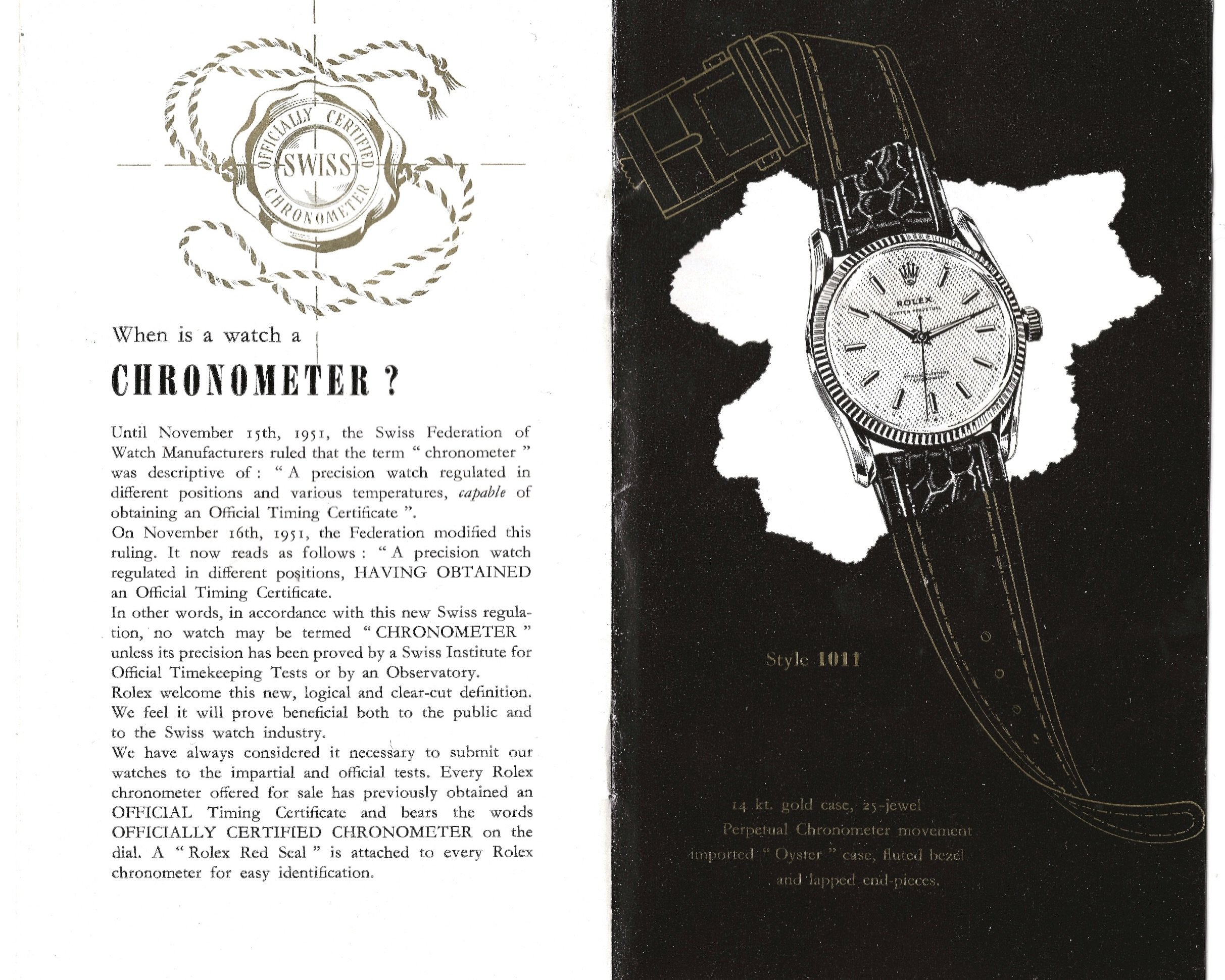
For some Rolex chronometers, you will notice the accompanying certification papers from the Bureaux Officiels de Contrôle de la Marche des Montres. These are seen on Rolex watches until circa 1968 with the specific test results of a given watch (filled out day by day with the variation) and the papers are very cool for collectors. Most often these papers were thrown away, along with the box, by the original owner as there was no perceived value. At least one Rolex retailer had amassed over a thousand Rolex boxes and papers stuck in a back room as purchasers would say they didn’t want to take the box and papers with them when leaving the store. Nevertheless, they still represent a very cool piece of ephemera for those that appreciate the accessories and add-ons beyond wearing a nice sports watch. Be careful of fake papers – some unfilled chronometer papers have been filled out along with other materials to make watches into “full sets” worth 20-25% more than as a watch only. There have been various scandals including “Papergate” where collectors tracked watches being sold “naked” or watch only and then reappearing a month later with box and papers added. Around 1968, Rolex discontinued including the specific chronometer certificate for a given watch showing the testing date and results and went to a general paper certificate talking about chronometers and typically with a stamped serial number. Since 1973, Rolex has used Contrôle Officiel Suisse des Chronomètres (COSC) for certification.
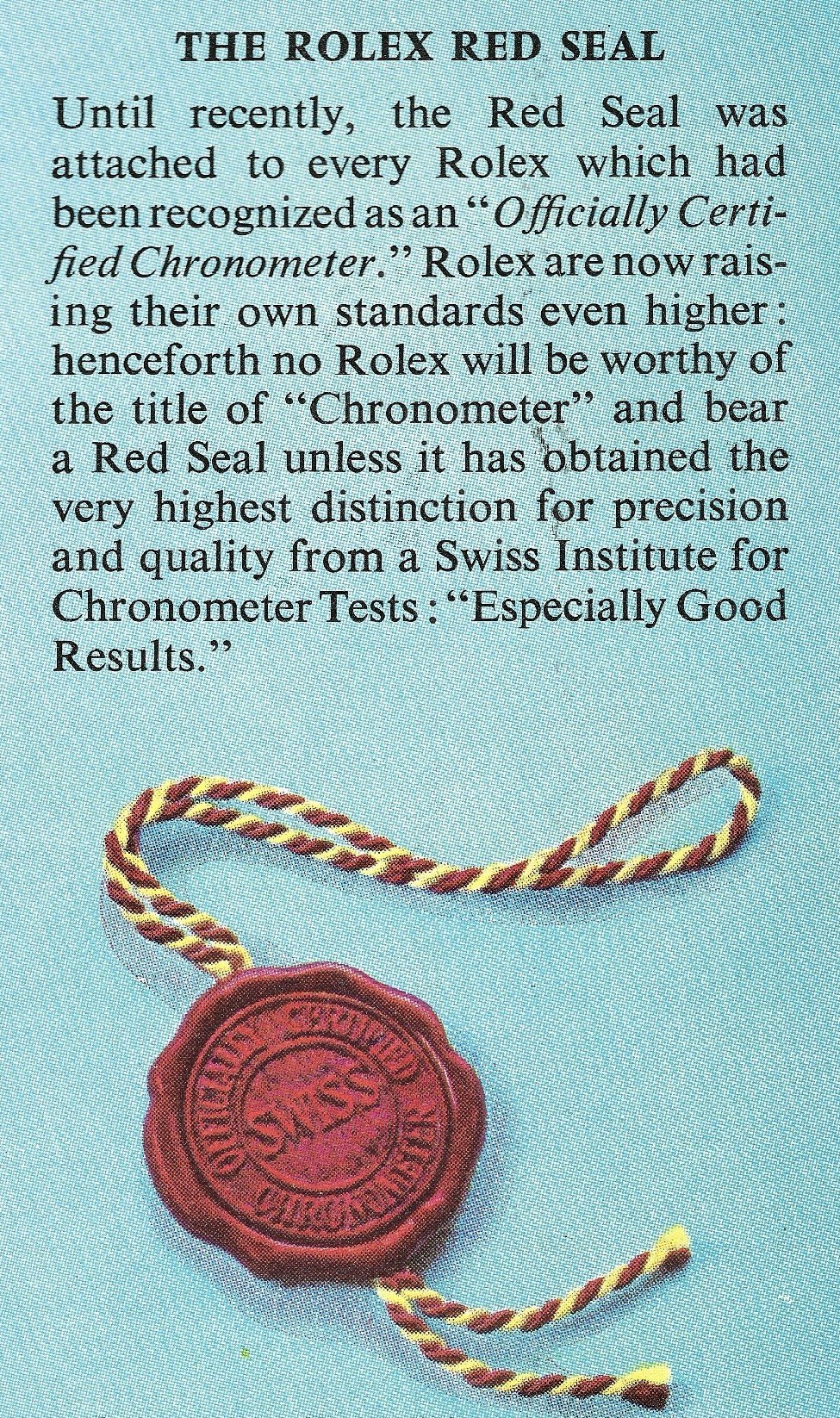
As far as the performance of a vintage chronometer, vintage Rolex watches still perform extremely well when taken care of and serviced by excellent watchmakers – even in comparison to modern chronometers from other brands. We would not suggest constant regulation or unnecessary servicing when a vintage Submariner is performing within less than 1 minute per day.

Bureaux Officiels de Contrôle de la Marche des Montres Chronometer certification papers (for a Rolex Datejust).
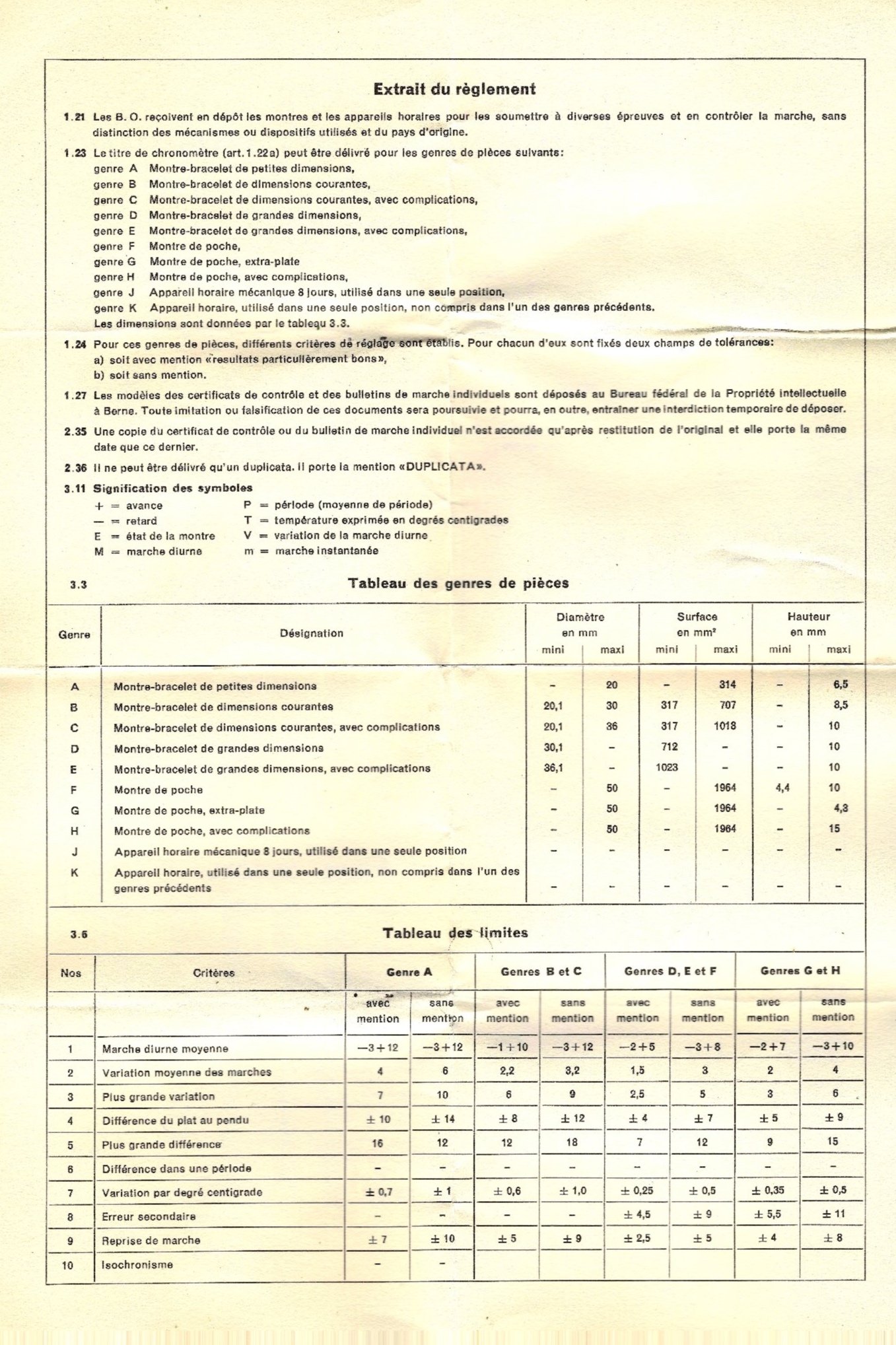
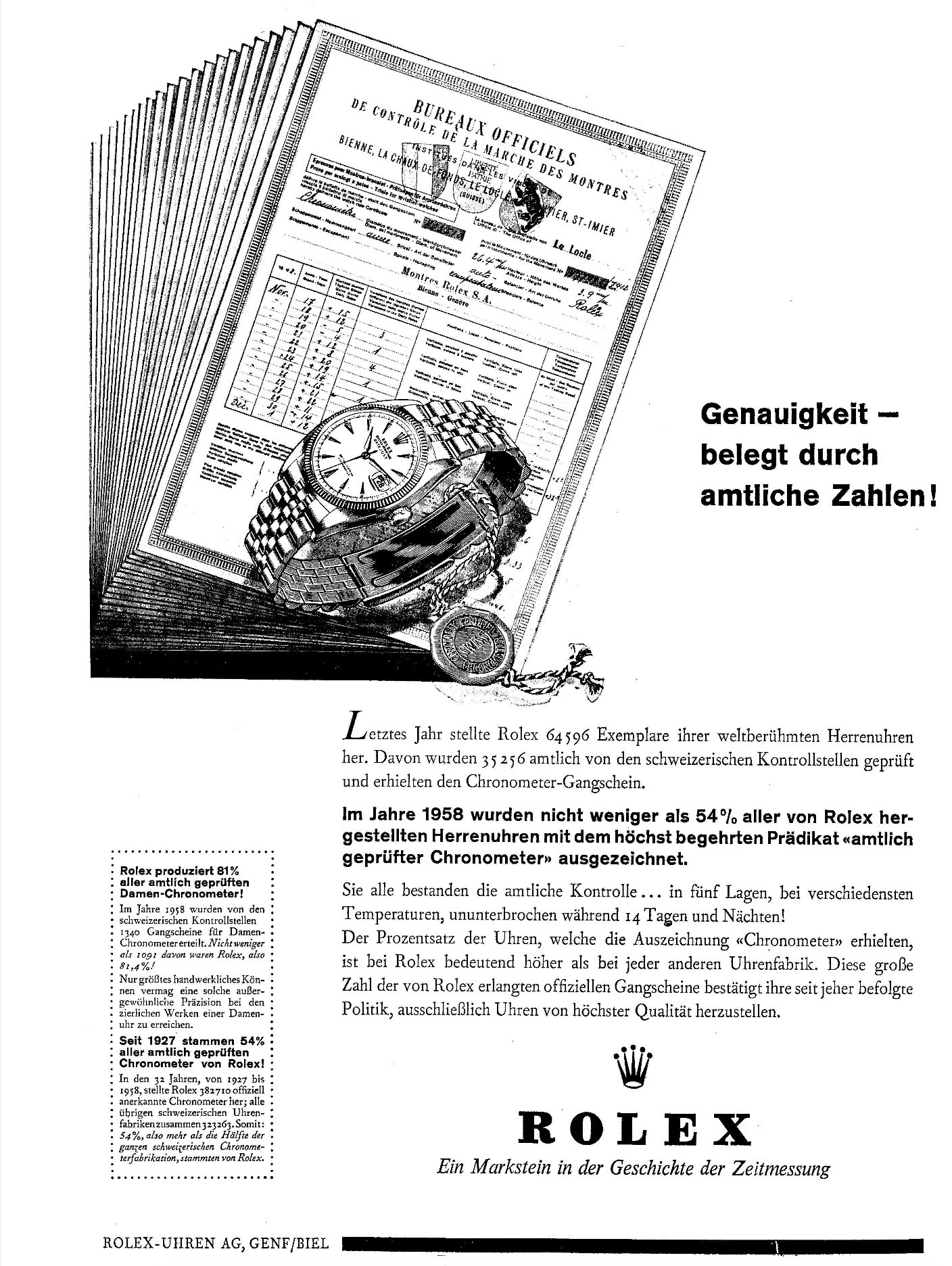
Der Bund, Volume 110, Number 162, 18 April 1959
“Last year, Rolex manufactured 64,596 examples of their world-famous men’s watches. Of these, 35,256 were officially tested by the Swiss inspection authorities and received the chronometer certificate.
In 1958, no less than 54% of all men’s watches manufactured by Rolex were given the highly coveted “official” designation “certified chronometer” award.
They all passed the official inspection… in five layers, at various temperatures, continuously for 14 days and nights! The percentage of watches that have received the “Chronometer” designation is significantly higher at Rolex than at any other watch manufacturer. This large number of official certificates obtained by Rolex confirms its long-standing policy of producing only watches of the highest quality.”
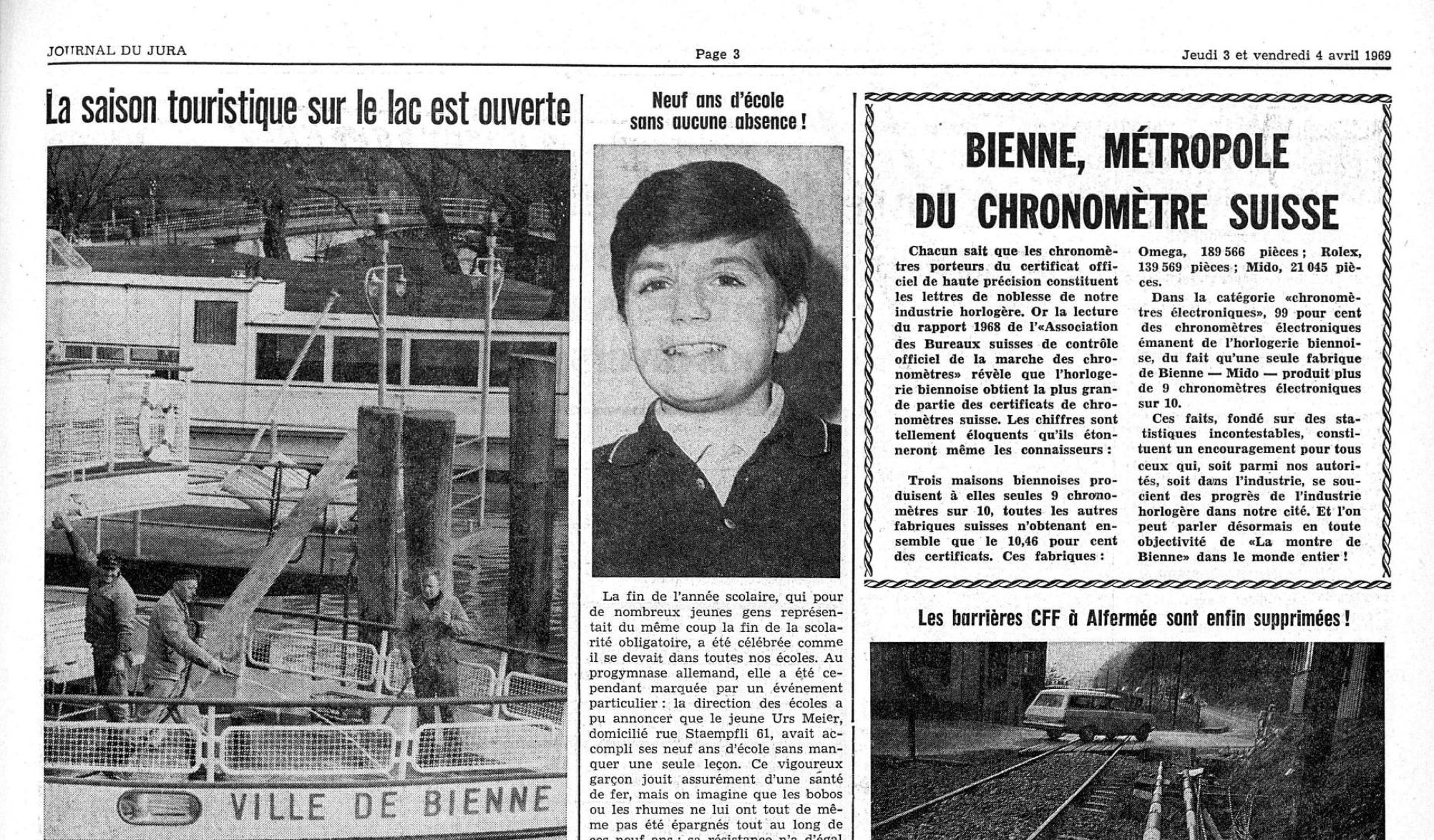
“Three companies in Bienne alone produce 9 out of 10 chronometers, all the other Swiss manufacturers together obtaining only 10.46 percent of the certificates. These factories:
Omega, 189566 pieces; Rolex, 139569 pieces; Mido, 21045 pieces. In the “electronic chronometers” category, 99 percent of electronic chronometers come from the Biel watchmaking industry, due to the fact that only one factory in Biel — Mido — produces more than 9 out of 10 electronic chronometers.”

“…Rolex S.A. continued to produce 217,000 chronometers, of course all with the legal certificate and award. This result – the largest number of chronometers manufactured by a company in Switzerland in 1972…” Image credit: Bieler Tagblatt, Number 104, 5 May 1973
Interestingly, Rolex sent two important chronometers to Dwight D. Eisenhower and Sir Winston Churchill that marked significant chronometer production. Churchill received the 100,000th Rolex chronometer (with his coat of arms in enamel on the case back) and Eisenhower received the 150,000th Rolex chronometer (which has since had its dial terribly reprinted).
With the additional efforts undergone by Rolex to have these movements transported to undergo testing then certification, the chronometer-grade Submariner models would be considerably more expensive (approximately 25% higher) than the non-chronometer Submariner reference 5513. This qualification certainly resonated and was a symbol of pride to many customers, but the majority of clientele would need to be educated on why this additional two lines of text was so important. Rolex would go to great lengths in their marketing over the following decades to emphasize the importance of superlative chronometers. These numbers are highlighted by the manufacturer in catalogs as well as cited in Swiss newspapers:
-
From 1927 to 1951, Rolex produced 500,000 chronometers.
-
In 1958, Rolex manufactured 64,596 examples of their world-famous men’s watches. Of these, 35,256 were officially tested by the Swiss inspection authorities and received the chronometer.
-
By 1965, Rolex had been awarded more than 700,000 Official Timing Certificates for wrist-chronometers — or nearly half of the entire Swiss chronometer production during the last 50 years.
-
By 1971 Rolex had produced 1.5 million chronometer wristwatches.

